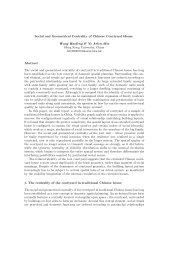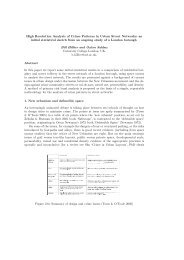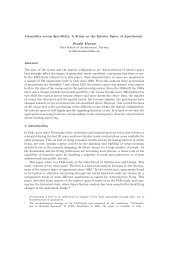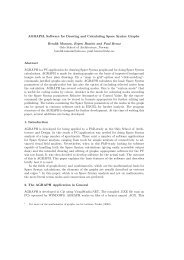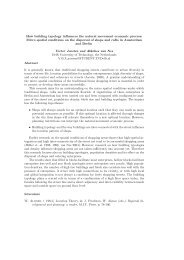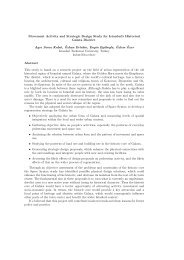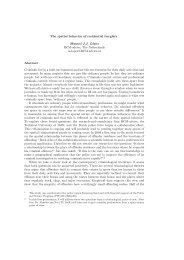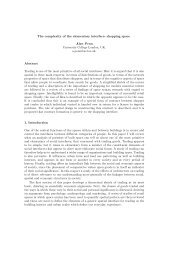The Role of Space Syntax in Identifying the Relationship Between ...
The Role of Space Syntax in Identifying the Relationship Between ...
The Role of Space Syntax in Identifying the Relationship Between ...
Create successful ePaper yourself
Turn your PDF publications into a flip-book with our unique Google optimized e-Paper software.
<strong>The</strong> <strong>Role</strong> <strong>of</strong> <strong>Space</strong> <strong>Syntax</strong> <strong>in</strong> Identify<strong>in</strong>g <strong>the</strong> <strong>Relationship</strong><strong>Between</strong> <strong>Space</strong> and Crime 419<strong>of</strong> <strong>in</strong>tersect<strong>in</strong>g axial l<strong>in</strong>es. In simple terms, <strong>the</strong> axial map is represented by <strong>the</strong> longestl<strong>in</strong>es <strong>of</strong> sight that can be used to characterize every street segment <strong>in</strong> <strong>the</strong> Ypsilanti area.For example, if two people were stand<strong>in</strong>g at each end <strong>of</strong> <strong>the</strong> l<strong>in</strong>e, <strong>the</strong>y will be able to seeeach o<strong>the</strong>r. <strong>The</strong> l<strong>in</strong>es were drawn manually on top <strong>of</strong> <strong>the</strong> map us<strong>in</strong>g Spatialist. Ypsilanticomprised an average <strong>of</strong> 634 axial l<strong>in</strong>es.Second, <strong>the</strong> program calculated <strong>the</strong> Integration and Connectivity values <strong>of</strong> every l<strong>in</strong>e<strong>in</strong> <strong>the</strong> system (Figure 195). To elaborate on <strong>the</strong>se two measures, Connectivity gives <strong>the</strong>number <strong>of</strong> l<strong>in</strong>es that are directly connected to a specific l<strong>in</strong>e. Integration, on <strong>the</strong> o<strong>the</strong>rhand, is an <strong>in</strong>dicator <strong>of</strong> how easily one can reach a specific l<strong>in</strong>e. Ma<strong>the</strong>matically speak<strong>in</strong>g,it is <strong>the</strong> average number <strong>of</strong> spaces that one needs to pass through to reach a specific l<strong>in</strong>efrom all <strong>the</strong> axial l<strong>in</strong>es <strong>in</strong> <strong>the</strong> system. In o<strong>the</strong>r words, <strong>the</strong>se values suggest <strong>the</strong> extent towhich a selected space <strong>in</strong> <strong>the</strong> system is more <strong>in</strong>tegrated (can be easily reached from o<strong>the</strong>rspaces), or more segregated (one has to travel through many spaces <strong>in</strong> order to reach thatselected space).S<strong>in</strong>ce <strong>the</strong> unit <strong>of</strong> analysis is <strong>the</strong> axial l<strong>in</strong>e (or <strong>the</strong> street space), it was necessary toappend sociodemographic data along with crime data to each l<strong>in</strong>e. <strong>The</strong>refore, a road map<strong>of</strong> Ypsilanti was prepared show<strong>in</strong>g 21 block groups us<strong>in</strong>g ArcGIS. Data on populationdensity, youth concentration, level <strong>of</strong> education, percentage <strong>of</strong> owners, age distributionand racial composition were available from U.S. Census and were appended to each blockgroup <strong>in</strong> Ypsilanti. <strong>The</strong> report on crime at an address level was semi-manually entered<strong>in</strong>to <strong>the</strong> same database (Figure 195). Moreover, <strong>the</strong> orig<strong>in</strong>al axial map that was preparedus<strong>in</strong>g Spatialist was later converted <strong>in</strong>to an appropriate format and was given accurategeographic coord<strong>in</strong>ates for Ypsilanti. This procedure allowed us to match <strong>the</strong> Spatialistaxial map with <strong>the</strong> ArcGIS Ypsilanti road map (Figure 196). <strong>The</strong> ‘Jo<strong>in</strong> Attribute’ feature<strong>in</strong> ArcGIS allowed us to merge <strong>the</strong> data on <strong>the</strong> axial map with <strong>the</strong> rest <strong>of</strong> <strong>the</strong> data.<strong>The</strong> f<strong>in</strong>al database that was produced <strong>in</strong> ArcGIS was later converted <strong>in</strong>to an acceptableSAS format. SAS is a statistical package that enabled us conduct a Poisson Regressionmodel<strong>in</strong>g <strong>of</strong> our data s<strong>in</strong>ce <strong>the</strong> crime report was collected over a period <strong>of</strong> a year.3.3. Statistical Analysis<strong>The</strong> MIXED Procedure <strong>in</strong> SAS (Version 9) was used <strong>in</strong> <strong>the</strong>se analyses to fit l<strong>in</strong>ear mixedmodels to <strong>the</strong> collected data. Because <strong>of</strong> <strong>the</strong> count nature <strong>of</strong> <strong>the</strong> response variables, squareroottransformations were performed <strong>in</strong> order to satisfy <strong>the</strong> assumptions <strong>of</strong> normality andconstant variance <strong>in</strong> random errors. In <strong>the</strong> mixed models, <strong>the</strong> fixed effects <strong>of</strong> physical andsociodemographic variables <strong>of</strong> <strong>in</strong>terest on crime counts collected over one year <strong>in</strong> givenstreet-spaces or axial l<strong>in</strong>es were estimated. Because <strong>of</strong> <strong>the</strong> clustered nature <strong>of</strong> <strong>the</strong> data,axial l<strong>in</strong>es were clustered with<strong>in</strong> randomly selected block groups, random <strong>in</strong>tercepts andrandom connectivity effects associated with <strong>the</strong> randomly sampled block groups were also<strong>in</strong>cluded, to test <strong>the</strong> hypo<strong>the</strong>sis that <strong>the</strong> crime counts and effects <strong>of</strong> connectivity on crimecounts tend to randomly vary from one block group to ano<strong>the</strong>r. Parameters <strong>in</strong> <strong>the</strong> modelwere tested us<strong>in</strong>g likelihood ratio tests, ei<strong>the</strong>r based on maximum likelihood (for fixedeffects) or restricted maximum likelihood (for variance parameters associated with <strong>the</strong>random effects).



